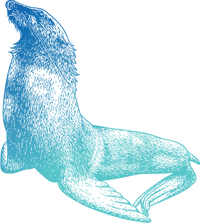This story was written by guest writer Lyda Harris, Ph.D., microplastics fellow at the Seattle Aquarium.
The Seattle Aquarium’s unique location and ongoing monitoring efforts enabled us to publish the first long-term monitoring of microparticle concentrations in an urban waterfront of the Salish Sea as a scientific paper. Our paper, titled Temporal variability of microparticles under the Seattle Aquarium, WA: Documenting the global Covid-19 pandemic, is available online.
Human-generated (or “anthropogenic”) debris on the ocean’s surface, within seabeds and on the beach is up to 80% plastic. Microplastic, or small plastic less than 0.2 inches (five millimeters) in size, is widespread in the marine environment and within every group of marine organisms that has been studied. Once ingested, microplastics can cause multiple health issues in marine animals, such as lower birthrate and increased susceptibility to disease. It isn’t just the physical properties of microplastics that negatively affect animals, however. Due to plastic’s petrochemical origin (fossil fuel), plastic particles act as a sponge and transportation method for persistent organic pollutants and other chemicals that are toxic.
We define “microparticles” (less than 0.2 inches, or the size of a sesame seed) as a single umbrella term to encompass all suspected micro anthropogenic debris, including microplastics.
We still don’t know what the baseline concentrations of anthropogenic debris are and how they shift seasonally, which is critical information for researchers to determine how local species, including humans, are impacted by shifts in microparticle loads. Thus, it’s important to measure long-term microparticle concentrations to establish a baseline across time, document anomalies and help researchers understand if there are certain times (e.g., seasonal rains, combined sewage overflows, tourist seasons, etc.) when the Salish Sea is more at risk from microparticle pollution.
Initially, the Seattle Aquarium set out to establish baseline microparticle concentrations and seasonality in Elliott Bay through ongoing water column sampling. Our study period, 2019–2020, occurred prior to and during the global COVID-19 pandemic with associated reductions in human activity, presenting an unprecedented opportunity to capture pre- and mid-pandemic contamination baselines.
Our goals were two-fold:
- Describe long-term microparticle contamination data, including concentration, particle type and particle size.
- Determine if seasonal microparticle concentrations are dependent on environmental or tourism variables in the Salish Sea’s Elliott Bay.
We sampled 26 gallons (100 liters) of seawater at depth (approximately 30 feet) under the Seattle Aquarium every two weeks in 2019 and 2020. Environmental and tourism data from public sources such as precipitation, Duwamish River effluent (outgoing water), wastewater effluent, and tourism were used to explain changes in microparticle concentrations. Lastly, 10% of microparticles were subsampled to test for plastics at Oregon State University.
Findings:
- Microparticle concentrations ranged from 0 to 3.4 particles per gallon (or 0–0.64 particles per liter).
- Fibers were the most common type observed.
- A drastic decrease in microparticle concentrations occurred on April 10, 2020, and was identified as a breakpoint, separating two distinct time periods.
- The observed change in microparticle concentrations was found to be correlated with a decrease in tourism that occurred along Seattle’s waterfront at the onset of the global COVID-19 pandemic.
- All microparticles that were analyzed for plastics were either anthropogenic (reminder: “human generated”) in material (80%), plastic (16%), or possibly anthropogenic or natural (4%).
Overall, we found a decrease in concentration as well as a potential change in the microparticle source. Decreased tourism from pandemic shutdowns led to a smaller urban population, which may have additional effects on human movement, wastewater effluent, and waterfront activity. All of these anthropogenic factors can affect both the concentration as well as composition of microparticle pollution in Elliott Bay.
The decline in tourism and subsequent lack of activity on the waterfront decreased the quantity of microparticle pollution we observed. However, the long-term COVID-19 effects on marine debris remain unknown. The microparticles we found were primarily fibers and likely not from single-use plastics, but rather from the washing and shedding of clothing (e.g., fleece, leggings, rain jackets, etc.).
While the quantity of microparticles found in this study decreased with the onset of COVID-19 and stay-at-home orders, global single-use plastic consumption increased substantially. When plastic enters waterways, it is degraded by UV rays and broken apart by physical forces, such as wave action, over time. As single-use plastic consumption remains high throughout the pandemic and the foreseeable future, it is possible that as these plastics break apart, they will begin to appear in future water samples.
While microparticle contamination along Seattle’s waterfront is relatively low and mostly consists of fibers as of 2020, future conditions are likely to worsen due to a return of tourism and current consumption and waste of single-use plastics.
